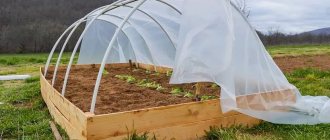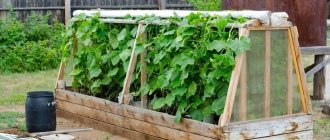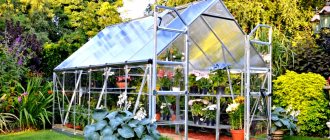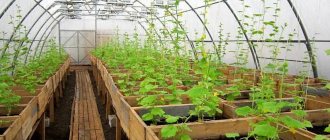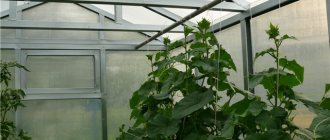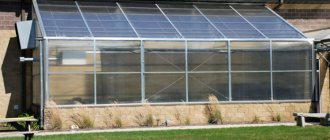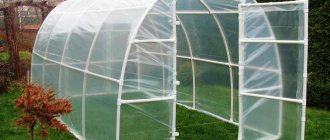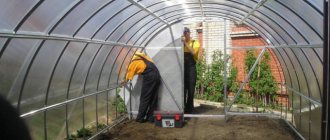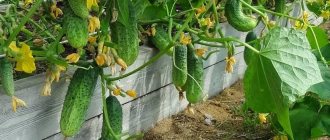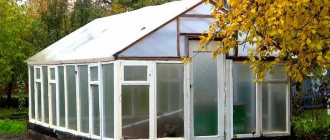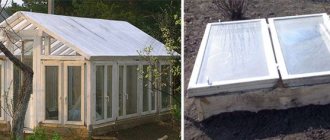In this article we will look at how to cover a greenhouse with film with your own hands, we will tell you what methods of attaching translucent material exist, what technologies help to quickly and correctly stretch the film onto the shelter frame. After reading the material, everyone will be able to calculate the amount of materials needed and choose the most suitable way to create a favorable microclimate for heat-loving plants.
A small greenhouse is covered with film Source stroy-podskazka.ru
Film, polycarbonate or glass: which is better?
Even at the initial stage, it is important to decide whether it is better to cover the greenhouse with a film or a covering material of a denser texture. The choice becomes much easier if priorities are set correctly. When the greenhouse is assembled in the spring for growing seedlings, you can get by with film. It is the cheapest covering material, which allows you to assemble a shelter in a couple of hours. One person can do the job.
In winter, the film is removed, the ground is exposed, covered with snow, and saturated with moisture. This has a beneficial effect on the ecosystem of the site. In closed greenhouses, in the absence of heating, the soil freezes to the deepest layer, causing the death of microorganisms, the activity of which improves the quality of the soil.
If you plan to use the greenhouse during frosts, you can cover it with polycarbonate sheets. This is a durable material, easily withstands wind and snow loads, and reliably protects plantings from weather influences.
Polycarbonate greenhouse in winter Source alyanssd.ru
It is chemically inert, so it is allowed to use the entire range of chemical fertilizers inside such a greenhouse. The special structure of the material provides high thermal insulation characteristics, but it transmits little light, so the inside of the greenhouse has to carefully consider artificial lighting and then increase the cost of paying for electricity.
In the hot season, there is a need to close the shelter from bright daylight. It greatly heats up the temperature inside the greenhouse, which has a bad effect on plant growth. Anyone who understands how to cover a polycarbonate greenhouse from the sun can easily cope with the problem of preserving the harvest. Typically, reflective film is used in such situations. It is laid directly on top of the building frame.
When the question is what to cover a greenhouse with other than polycarbonate, glass is usually chosen. This is the most expensive way to organize the cultivation of plants during the cold period, but the most effective. Usually it is used mainly for organizing year-round cultivation of plants.
Greenhouse covered with glass Source zimsad-master.ru
Its choice is considered inappropriate from an economic point of view if the greenhouse “operates” periodically, from time to time. In situations where the shelter is used from May to October, it is better to cover it with film. This design has its own characteristics, understanding them allows you to extract maximum benefit.
PVC film
PVC film is similar in characteristics to light-stabilized polyethylene, but at the same time has increased elasticity and strength. You can distinguish PVC film from polyethylene by its absolute transparency without a bluish matte tint. Due to its resistance to cracking, the transparency of the film is maintained throughout its entire service life. The light transmittance of PVC film is close to 90%.
PVC film
The film is sold in rolls with a length of 50 to 150 m and a web width of 1.4-1.5 m. The thickness of PVC film is 150 microns. The surface texture is smooth and sliding, which ensures poor wettability - water drops simply bounce off the material.
Advantages of PVC film:
- high degree of protection against UV radiation - it is converted into blue and cyan wavelengths useful for plants;
- the ability to retain heat well inside the greenhouse due to poor transmission of infrared radiation;
- the breathability of the material allows plants to breathe and improves thermoregulation;
- high hydrophilic properties;
- the film is not prone to cracking and contamination;
- antistatic properties prevent dust settling and film clouding;
- high elasticity eliminates ruptures and damage due to careless handling, hail and wind;
- The service life of PVC film is at least 4 years without removal from the frame for the winter period.
Flaws:
- higher price than polyethylene;
- Proper disposal is required.
Greenhouse covered with PVC film
The elasticity of PVC film allows it to be stretched 1.5-1.7 times without damage, after which it will return to its original shape. This property is useful for greenhouses and greenhouses with a low roof slope, when water can accumulate in the film cover. In this case, polyethylene breaks.
Note! When PVC film is burned, a poisonous gas is formed that paralyzes the respiratory system. You cannot burn it along with garden waste!
Device principle
The protective shelter, which is created using a frame and film, is used only for growing seeds and seedlings of garden crops. It absorbs the sun's rays and converts them into thermal energy. Inside the greenhouse it is always several degrees warmer than outside, even without additional heating. Its installation helps to create a microclimate favorable for the growth of garden crops. The shelter reliably protects crops from precipitation, strong winds, and prevents the penetration of insects that can harm seedlings or adult plants.
In order for the greenhouse to work efficiently, during its installation it is necessary to correctly calculate the amount of covering material. To do this, you need to make calculations and take correct measurements. It is easier to solve the problems when the length of the frame and the width of the covering material are known.
The calculation requires the length of the greenhouse and the width of the film Source greentalk.ru
See also: Catalog of country house projects
If the structure of the greenhouse is arched, the length of the canvas should be equal to the length of the arc. When the greenhouse has a frame with a “pitched roof”, the film is calculated taking into account the height of the walls and the length of the slopes. The resulting figure should be equal to the length of the film. To find out how many of these pieces are needed to completely cover the shelter, you need to divide the length of the greenhouse by the width of the film. Since individual pieces are then overlapped, it is important to add 25 cm to the width of each piece (for allowances).
In order for the greenhouse coating to ensure the performance of its functions, it is important to pay attention to the following nuances:
- It is better to cut the covering material on site. It will be much easier to do this if you lay the roll next to the frame in width, and then throw it across the structure, stretch it well on both sides, add 25 cm to the right and left for allowances, and only then cut off the first piece.
- The second strip is cut in the same way. It is laid over the first one with an overlap (25 cm) and secured with construction tape.
- As many pieces are cut as needed to cover the greenhouse from start to finish.
- The ends are cut in the same way and also with allowances of 25 cm.
- Doors and windows are cut out after installing and attaching the film.
Film strips are laid overlapping Source 9dach.ru
Note! It is better to cut the film in calm weather; if the covering material sways and bends under gusts of wind, it will not be possible to stretch it properly.
Knowing how to cover a greenhouse with film, it is not difficult to calculate the amount of covering material. But when buying it, it is important to look at the form in which it is sold. Polyethylene film has a standard width. It is equal to 150 cm. But some manufacturers sell rolls in the form of a sleeve. Before covering the greenhouse, it will have to be cut along one edge of the bend and unfolded.
See also: Catalog of companies that specialize in the installation of metal structures
Light-stabilized hydrophilic film
Thanks to the introduction of various additives into the polyethylene structure, stabilized films have improved characteristics and a long service life - up to 6 seasons. You can leave it on the frame for the winter - thanks to the UV blocker and plasticizer, the film is not destroyed by frost and aggressive spring sun.
Light stabilized film
In addition, UV filters prevent the penetration of ultraviolet radiation into the greenhouse, which inhibits the activity of pathogenic microorganisms and pests - thrips and whiteflies without UV rays lose orientation in space and die. Hydrophilic additives prevent the appearance of drops and the accumulation of dust on the surface of the film, so the film does not lose transparency for a long time.
The film is produced in rolls of standard sizes: length 50 or 100 m, sleeve width 1.5, 2 or 3 m. The thickness of the stabilized film can be from 100 to 200 microns. Film with stabilizers can be transparent with a slight blue tint or colored. Over time, the pigment may partially fade, but this does not affect the properties of the film.
Greenhouse light-stabilized film, 150 microns, 6 m width
Advantages of stabilized polyethylene film compared to conventional polyethylene:
- extended service life - up to 6 seasons or 3 years without removing the coating;
- increased strength and elasticity;
- increased heat capacity;
- absence of condensation and dew;
- good light transmission for a long time;
- inhibition of viruses, bacteria and fungi, as well as pests.
The disadvantages include a higher price, but the costs are recouped over several years of using the film. It is advisable to install them on non-demountable greenhouses, including those for winter use - they often suffer from whitefly attacks.
Note! In southern regions with hot daytime sun, you can use colored light-stabilized film - it transmits less light, so the plants will not overheat.
Prices for light-stabilized film
light stabilized film
Characteristics of different films
When deciding how to cover a greenhouse, it is important to determine what functions it will perform: in winter, to protect plantings from frost, or in warmer times of the year, to help seedlings ripen faster and bear fruit. Clearly defined goals help you choose the right coating material.
Polyethylene film is suitable for covering greenhouses used in the warm season. It is removed for the winter, the frame is disassembled and reinstalled in the spring. For such events, roll material with a thickness of 150-200 microns is most suitable.
Marking of polyethylene film Source fishing-caravan.ru
Reinforced film is ideal for those who want to install a greenhouse once and then use it for three years without disassembling or removing the shelter for the winter. The density of this material is 150–200 g/m².
PVC film is a good choice for winter greenhouses. They help grow plants even at -15 degrees below zero. During the day, the material does not let the sun's rays through; at night, the film retains heat well.
Frost-resistant film is used to create industrial greenhouses. It can last more than seven years and does not stretch during its entire service life. Easily withstands hail and is not damaged.
Amateur gardeners, studying the offered assortment, often wonder what is the best way to cover a greenhouse. Experts advise using the first three types of film. They are inexpensive and can be used to quickly cover a greenhouse for growing a small volume of garden crops.
Properties of film coatings
Polyethylene film is used not only in agriculture, but also in construction, as well as for packaging various goods. However, not every roll film is suitable for covering greenhouses. Types of film made from low-density polyethylene have low strength and do not tolerate temperature changes and solar radiation. Such a film becomes deformed and breaks within 2-3 months in summer, and cracks when the temperature drops below -10°C in winter.
Professional greenhouses under film
There are several types of film for greenhouses:
- made of high-density polyethylene;
- light-stabilized polyethylene;
- light-transforming, heat-retaining film;
- ethylene vinyl acetate copolymer film “Svetlitsa”;
- PVC film;
- reinforced polyethylene;
- air bubble, thickness from 4 to 10 mm.
Films for covering greenhouses, regardless of type, have general advantages and disadvantages.
Features of film coverings for greenhouses:
- simple installation, repair or replacement of film;
- light weight and low load on the frame;
- large selection of thickness, width and types of film.
Greenhouse with film
Prices for PVC film
PVC film
To improve the characteristics of the film, various components are added to the polymer, giving it special properties.
- Light stabilizers are components built into the polymer chains of a material and reduce the harmful effects of solar radiation on the structure. Film with light stabilizers does not deteriorate after several months of use, even under the bright spring and summer sun. In addition, light-stabilized film has greater elasticity and frost resistance; it does not have to be removed for the winter.
Light stabilizers or UV stabilizers
- Thermal stabilizers increase the film's resistance to elevated temperatures, which is important when using the coating on a metal frame.
- Antistatic additives prevent the formation of a static charge on the surface of the film, so it does not attract dust and contaminants that impair its transparency. The light transmittance of such a film practically does not decrease over the entire period of use.
- Anti-blocking components prevent sticking of film layers - this property is important for long-term storage of covering material.
- Hydrophobic additives prevent the formation of large drops of condensation that can cause burns to plants. Moisture on such a film is distributed in a thin layer and flows down, practically without impairing the light transmission of the coating. In the film characteristics they are also called antifog.
- Sliding additives improve the plasticity and smoothness of the film surface, making it more pleasant to use.
- Phosphors are components that help convert ultraviolet light waves that are useless for plants into the visible part of the spectrum. This increases plant illumination and accelerates photosynthesis and growth. Another feature of light-transforming films is the weak transmission of infrared rays to the outside, due to which the greenhouse releases heat more slowly at night.
Adding just 1% antistatic agent 104355-E is enough to prevent dust accumulation on the surface of EVA films
The effect of using chalk additive F-2 in LDPE film of various thicknesses
The influence of a combined additive (sliding + antistatic agent) on the technical parameters of a film produced by blowing a high-density polyethylene sleeve
Comparative results of phosphor service life in film
Note! Identifying film with phosphors is quite simple: you need to shine an ultraviolet lamp or blue LEDs through it. The light passing through the film should turn red.
Film fastening elements
When cutting the film, its initial fastening is done using tape. You cannot leave the greenhouse like this: the first strong gust of wind will tear the covering. The correct choice of fastening type will help prevent this. It depends on what type of frame is used to create the shelter.
Clamps for film on a greenhouse Source semopt.ru
Rail fastening
Not everyone knows how to attach film to greenhouse arches made of wood. The method of fixing rolled material is actually extremely simple:
- small wooden blocks 10 cm long are cut;
- processed with sandpaper;
- then wrapped in several layers of polyethylene film;
- the first layer, the one that will come into contact with the frame of the greenhouse, is coated with rubber glue;
- The block is applied to the fastening point, and then fixed with a self-tapping screw for reliability.
Attaching the film to a wooden frame with slats Source fishing-caravan.ru
The presence of glue under the attachment point ensures a tight connection, which extends the service life of the shelter. When wooden slats are not available, pieces of old linoleum or plastic tape, which is used for packing boxes, can replace them. It is attached to the wooden frame using a construction stapler.
If you need to decide how to attach the film to a metal greenhouse frame made from a profile, you should use the following advice. It is better to fix the covering material with wooden blocks, but they should be fastened with self-tapping screws not to the frame arc itself, but to the ends of the greenhouse, to its metal posts. When the frame of the greenhouse is assembled from reinforcement rods, the easiest way is to attach the film to it with office clothespins (these are used to fasten sheets in a folder).
What problems can bother you and how to solve them?
Some people still solve the above problem of moisture from film quite successfully. Here's how everything can be done: we put a film between the posts - especially for water drainage. You can use old drip tape for this. Just leave 7-10 cm unfinished to the end - so that the warm air that rises up enters this span, cools from the upper film, the steam turns into water and, dripping onto the lower film, flows down.
There is another problem that quite annoys all owners of greenhouses with a metal structure - the metal rubs the film. It breaks and quickly becomes completely unusable. This can be solved effectively in two ways: wrap the frame in such places with fabric, which is not very aesthetically pleasing, of course, or cover them with tape. By the way, there are usually no such problems on a PVC frame.
The third problem: heating. If the iron frame is painted with light paint, the metal itself will heat up less and heat up the film. But keep in mind that the paint will scratch it even more. The second option is to put rubber on the frame and paint it white so that it heats up less. Plastic pipes, hose pipes and bicycle tires also cope well with this problem. All white-painted parts already heat up in the sun exactly half as much!
And finally, when stretching the film over the frame, remember one thing: every year it tightens. So, if at first you purchased 6 m, then after two years you will notice that the length of the coating is already exactly 5.90, and in this arithmetic progression this process will continue. And if you stretch it on the frame, then it will simply tighten more and more. Therefore, never pull it too hard, especially if you keep the film until the coldest weather.
Mesh fastening
Some gardeners use another simple method of attaching rolled material. They cut the film, connect the individual parts together with double-sided tape, stretch the covering material onto the greenhouse, fix it at the bottom with clips or bars, and lay a coarse mesh over the top area. It is attached to the frame of the greenhouse using wire. This method has its pros and cons. The practice of using such structures shows that they cannot withstand strong winds. Every time after another bad weather, the greenhouse has to be re-tightened.
Industrial Arc Sets
The kits are arches made of insulated wire or pipes bent according to one template. The set usually contains 6 arches, they are designed for a tunnel shelter or a temporary greenhouse 4-6 m long. The dimensions of the arches - width and height - can be different, from 65 to 120 cm. The arches can also be sold individually - in this case, you can complete a set for greenhouse of the required length.
For the manufacture of arcs the following can be used:
- steel wire Ø5 mm in PVC sheath;
- steel tube Ø10-Ø12 mm in PVC sheath
- PVC pipe Ø20-Ø25 mm.
The wire and tube arches are rigid enough to maintain their shape for several seasons. PVC insulation protects them from corrosion, and pins at the ends make it easier to anchor them in the ground. The arcs are simply stuck into the ground to the required depth.
Arcs made from PVC pipes are more flexible, due to this you can adjust the width and height of the greenhouse. To secure it in the ground, you can use special pegs for PVC pipes or cutting reinforcement.
Special clamps are used to attach the covering material to the arches. To hold the canvas on the ground and protect it from the wind, you can purchase a set of pegs and rings. The pegs are stuck into the ground, covered with covering material and clamped with a ring. Covering material, sets of clamps and pegs, as a rule, are purchased separately, focusing on the number and size of the selected arches.
Note! Sets of arcs can be used to make a permanent greenhouse. To do this, it is enough to assemble a frame from boards and bars and attach the arcs to it.
Prices for arches for greenhouses
Fastening with rope and harness
Buying a mesh increases the cost of installing a greenhouse; if you want to save money, you can try fixing the film with a polypropylene cord or an elastic band. They are first fixed with a knot on the lower part of the first arc of the frame, and then thrown over it, stretched and fixed on the opposite side of the frame. Then they are thrown again and fixed on the next arc of the base. The film is attached in this way, in a zigzag manner.
Fastening with eyelets
It can be used if a very dense film is used to cover the greenhouse. It is first cut into strips. Holes (openings) are made along the edges on one and the other side of the future canopy. They are then reinforced with a plastic or metal ring. A cord is threaded through it, with the help of which the film is attached to the frame of the greenhouse.
Film with a metal eyelet Source klen.by
The strips are connected to each other by soldering. To carry it out, an iron, blowtorch or alcohol lamp is used. First, the strip fragments are folded together, then they are covered with old newspapers, and only after that they are ironed or processed with a soldering iron. During this procedure, it is important to observe the temperature regime; you cannot hold the selected instrument over the coating material for a long time.
Technologies do not stand still; today materials are appearing on sale that make it possible to improve the design of shelters for plants and reduce their cost.
Stationery binders
This is a method similar to using clamps, but is more suitable for reinforcement structures. To secure the film with binders, you must first lay it on top of the greenhouse and tighten it tightly. Then it is better to place rubber or a piece of fabric under each fastener. The clips can tear the film, especially in strong winds.
This method is interesting and reliable, but the main drawback of binders is the material from which they are made. They rust quite quickly, unlike plastic clamps. If you do not have a huge number of them, then it is better to abandon this idea. It will cost a lot of money to buy new clamps.
Juicy roll made from simple ingredients: potatoes, cheese and ham
20 ml of peroxide per liter of water: 5 tips for growing strong pepper seedlings
Giant obsidian “blade”, 20 thousand years old, discovered in China
Briefly about the main thing
By understanding how and what to cover a greenhouse with, you can create shelters that can last in the garden for several years. Experts advise cutting it out right away and keeping a spare case on hand. It will help, in case of damage to the film, to replace it in time and prevent the death of plants. The method of fastening the covering material is selected taking into account what the frame is made of.
A little more attention!
What do you think - which method of attaching film to a greenhouse is more reliable? Maybe it is better to use polycarbonate or glass to cover the greenhouse?
Description of a greenhouse made of arcs with covering material
A greenhouse is a structure in which arches serve as supporting elements, and covering material serves as a means of protection from cold and wind.
Peppers are planted inside a three-arch greenhouse
To prevent the canvas from falling off the supports, “clamps” are used. They can be ordinary clothespins attached to the arcs, or heavy boards placed on the edges of the film falling from the arcs.
A structure made of arcs and covering material performs the same tasks as a greenhouse. The greenhouse is designed to protect the vegetables being grown from the wind and low air temperatures during cool summer nights and days. The warmth of the “tropical” climate is always retained inside the greenhouse.
The advantages of a greenhouse based on arcs include:
- quick and simple assembly of the structure;
- no need for a foundation;
- possibility of dismantling (at the end of summer, the arcs can be removed and used again a year later);
- insignificant construction costs.
The disadvantages of a greenhouse are:
- relatively rapid wear of the covering material;
- instability of the structure (during strong gusts of wind);
- inability to install a heating device, as in a greenhouse.
Photo gallery of arc greenhouses
Thanks to the fasteners, one side of the greenhouse can be easily opened
The greenhouse can be opened by tying the film on the middle arc
The metal presses the film well
The end sides of the greenhouse are covered with separate pieces of film
The end of the film is tightly twisted and covered with soil
The structure is covered with film
Non-woven material is stretched over the arches
Polycarbonate was used to create the structure
Reviews from gardeners
Many gardeners like to grow plants in a greenhouse. Moreover, they know some tricks that make using the device as convenient as possible.
And my husband made arcs for the greenhouse from 10 mm wire.
This one is sold in rings with a diameter of 3.5 m and costs 15 rubles. meter. I cut it in half with a grinder, and the arcs are ready. I pull the ropes well along the top and sides, with a film on top. OPriz
https://www.forumhouse.ru/threads/15357/page-2
For film clips on arches, especially metal ones (not thick ones), you can use clothespins and paper clips, only larger ones.
Irina R
https://www.forumhouse.ru/threads/15357/page-2
I made a greenhouse or greenhouse, I don’t know what to call it, 6x2m. I hammered in 45mm corners every 1m, attached a 32mm polyethylene pipe to them for the arcs, secured everything together with a plasterboard profile and covered it with film. It stood for a year this year. I want to cover it with polycarbonate. I need 4 sheets
Sabirdzhan
https://www .forumhouse.ru/threads/15357/page-2
